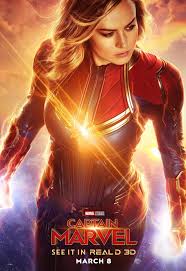
It’s official: Captain Marvel, the latest film in the Marvel Cinematic Universe—and the first to feature a solo female hero in the lead—is a hit, taking in $153 million at the box office domestically during its opening weekend, $455 million globally. It’s well on its way to $1 billion, probably more.
Not bad for a superhero with alcohol use disorder (AUD).
Well, OK, the MCU version probably isn’t an alcoholic, but the comic book version is. (Not was, is. Even superheroes can’t cure alcohol or substance use disorders.)
Most viewers probably knew very little about Captain Marvel before seeing the movie. That’s not surprising because although Carol Danvers (her alter ego) first appeared in a 1967 Marvel Comics series featuring a hero named Captain Marvel, Danvers did not adopt the name until 2012.
During the 45 intervening years, Carol Danvers was put through the wringer, enduring kidnapping, physical trauma, brainwashing, multiple personality disorder, rape, post-traumatic stress disorder (PTSD), blatant sexism, loss of memories, and—probably largely because of this record of abuse—alcoholism.
Alcoholism is sometimes the result of a genetic predisposition, sometimes a result of mental and physical abuse. Carol Danvers’ father may have been an alcoholic, and he may have physically abused Carol’s brothers. Personally, she experienced psychological abuse at his hands for things like wanting to go to college and have a career. Certainly, Carol Danvers went through enough to make such substance use disorder plausible.
When first introduced, Danvers was a military veteran (who had already experienced concussion and torture, possible forebears to PTSD) and security chief at a military installation. Also working in and around that same installation was a spy for the Kree (an alien race) named Mar-Vell. He becomes known as the superhero Captain Marvel. Later, he abandoned his espionage mission entirely and became a hero in earnest.
(That Marvel Comics published a character by that name was a legal or marketing issue: Marvel’s Powers that Be thought that they should protect their brand before someone else used it. Originally Captain Marvel was the name of a different superhero who was litigated out of existence by DC Comics. That hero was brought back—by DC!—and will soon appear in the DCU film Shazam.)
For a secret identity, Mar-Vell assumed the identity of a scientist who turns out to have been a bad guy. Danvers as security chief was looking into his actions, which Mar-Vell had to frustrate to maintain his own cover. At the same time, Danvers experiences an unrequited crush on a masked Mar-Vell, not realizing he is the object of her investigation. So the good guy was gas-lighting her.

On occasion, Mar-Vell has to rescue Danvers, most significantly from the revenge plot of his one-time Kree boss Yon-Rogg. In an attempt to kill Mar-Vell, Yon-Rogg employs a machine called the Psyche-Magnetron that creates whatever the mind envisions. When the machine eventually blows up, Danvers is near it, with consequences that do not become apparent for years.
Eight years later, Marvel Comics again thought they should protect their brand name by introducing another character named Marvel, this one a female—it was the 1970s, and they were at least paying lip service to feminism—to be called Ms. Marvel. They remembered Carol Danvers and her proximity to the Psyche-Magnetron and decided that the explosion of the machine had granted her unconscious wish to be a superhero who didn’t have to rely on someone else, even Captain Marvel, to rescue her.
So, the Psyche-Magnetron granted her the knowledge, DNA, powers, and even a costume modeled on Mar-Vell’s—although her outfit featured a lot more skin (a bare belly, back, and legs) plus a superfluous scarf—a shorter, feathered haircut, plus something called a “Seventh Sense” which gave her sometimes crippling premonitions of the future. (Later she gets a new costume, a sleeveless, legless leotard with thigh-high stiletto boots, long gloves, and longer hair.)
Also, for some reason, initially Danvers didn’t even know she was Ms. Marvel. She became the hero during blackouts that she could not explain. Apparently, these blackouts may have contributed to her losing the security chief gig. She instead became the editor of a women’s magazine, published by J. Jonah Jameson (Spider-Man’s newspaper nemesis).
Even when Danvers discovered the truth about her dual identity, she saw Ms. Marvel as a separate personality, a separate being with a separate agenda, who alone possessed the powers (super strength, flight, etc.). In one incident, Danvers receives a Seventh Sense flash that her best friend, an astronaut, is going to die in a rocket mishap. Danvers wants to try to save her, but Ms. Marvel decides to fight a menace that might threaten the Earth instead. (Priorities.)
It’s no wonder she was seeing a psychiatrist (who, quite inappropriately, is romantically interested in her.) Then her comic was canceled and she was relegated to guest spots in other characters’ comics until the worst thing yet happens: she joined the Avengers.
Well, that’s not the worst thing, but it leads to the worst thing. At some point, Danvers, who hasn’t been with a man in a while, discovered she was suddenly, somehow, pregnant. Worse, the pregnancy was developing at a highly accelerated rate. Worse still, the child, when born, was male and grew to adulthood at an even more accelerated rate. Then, as an adult, he not only tried to romance her but revealed that he has already done so!

He tells her his name is Marcus and he is a being from Limbo, a timeless dimension, and the son of an Avengers antagonist named Immortus. Marcus wanted to escape from Limbo but in order to do so he needed to be reborn on Earth. (Okayyyy…) So, naturally, he kidnapped Danvers, romanced her, influenced her mind and emotions with one of his super-scientific machines so she would fall in love with him, had sex with her, then sent her back to Earth with no memory of the event.
When Marcus’ plans to remain on Earth fell apart and he had to return to Limbo, Danvers decided to go back with him because she “loved” him. The Avengers, despite knowledge of all of Marcus’ machinations, think this is an acceptable idea. (The writer of this story, indeed all of the preceding stories, was a man.)
That’s the comic book explanation. More likely is that the writer, who was also Marvel’s editor-in-chief at the time, decided that the whole Ms. Marvel experiment had been a flop, and she needed to be expunged from the Marvel Universe.
A year later, one of the original writers decided to bring her back and explain that the previous storyline was abusive and criminal, not romantic. However, apparently the Ms. Marvel concept was still in the dustbin of history, so she loses her powers in a fight with a mutant named Rogue (the same character Anna Paquin played in the original X-Men movies).
Rogue, as was established in the movies, can temporarily steal the powers from other superheroes. She also borrows their knowledge and memories. If she’s not careful, however, she can steal them permanently. In this case, she wasn’t and she did. Rogue then tossed her powerless, amnesiac body from the top of the Golden Gate Bridge. Danvers lived but was left a tabula rasa, a blank slate, with none of her powers (although her DNA was still spliced with Kree DNA). With the help of the X-Men’s Professor Xavier, she regained most of her memories, but not the emotions behind them.
She tells the Avengers off and tries to rebuild her life by adventuring with the X-Men instead. This lands her in outer space where an evil alien (or should I say Alien because they in some ways resemble the critters in Ridley Scott’s Alien, including a birth cycle that requires implanting eggs in the victims’ chests) notices her peculiar human/Kree DNA and decides to conduct scientific experiments on her.
While painful, these experiments accidentally give her new powers, somehow connecting her to a theoretical object called a white hole (sort of a reverse black hole, but don’t ask me to explain it any more than that) that is a source of almost unlimited power. She looked like she was made of fire when she used her powers, mainly manipulating energy, burning things and flying really fast (plus the usual super strength and durability).

Now cosmically powered, and with no emotional ties to Earth, Danvers wandered around in space for a while using the new name Binary. And of course, she has a swimsuit-type costume (complete with thigh-high, stiletto-heel boots) when she’s not manifesting her powers.
When eventually she loses most of her Binary powers, Danvers returns to Earth and resumes her superhero career wearing a variation of her previous Ms. Marvel costume but using the code name Warbird. (It was the ’90s. War was cool. Iron Man had an associate named War Machine, too.)
This is when she becomes an alcoholic and starts screwing up.
Danvers was called on her behavior and addiction by fellow alcoholic Tony Stark/Iron Man (who had at least two storylines revolve around his own drinking problems), who tried to help her. At least once, they attended an Alcoholics Anonymous meeting together.
Not that she accepted and sought rehab for alcohol immediately. Like many addicts, she at first denied having a problem, then thought she could handle it on her own, then screwed up on a massive scale. A normal alcoholic might wreck a car. Danvers almost wrecked a plane in flight.
Let’s look at everything she went through again:
- Possible family history of alcohol use disorder.
- Kidnapping: Multiple times.
- Physical trauma, maybe concussion.
- Job frustration leading to loss of career.
- Multiple personality disorder.
- Being in effect gas-lighted by said other personality.
- Seeing a friend die who she could possibly have saved.
- Brainwashing.
- Rape.
- Physical assault.
- Various trauma, including the infliction of a more-or-less phantom pregnancy and giving birth to her rapist/assailant.
- Mental rape: Loss of memories.
- Physical torture.
- Being subjected to involuntary medical experimentation.
- The physical and mental trauma caused by the granting and removal of godlike superpowers.
And that was just the first 30 years or so. The Mayo Clinic lists family history, mental health problems, and trauma as three possible contributing factors to AUD.
She’s been through more since including re-adopting the name Ms. Marvel before passing it on and claiming the then-vacant name Captain Marvel. (Her old nemesis and friend Mar-Vell died in 1982 and the name passed on to other characters over the intervening decades.)
It’s doubtful the MCU films will include Carol Danvers’ alcoholism. For one thing, it’s a hard subject to deal with in a two, two-and-a-half hour film. Besides, the cinematic Danvers hasn’t been through a fifth of what the comic book version has experienced. (Multiple writers over decades, changing times, changing situations.)
But Captain Marvel has done more than well enough at the box office to merit a sequel or two. The plotline might come up yet.
Stephen Bitsoli writes about addiction, treatment, pop culture, and politics. A former magazine and newspaper writer, Stephen loves learning and sharing what he’s learned.
